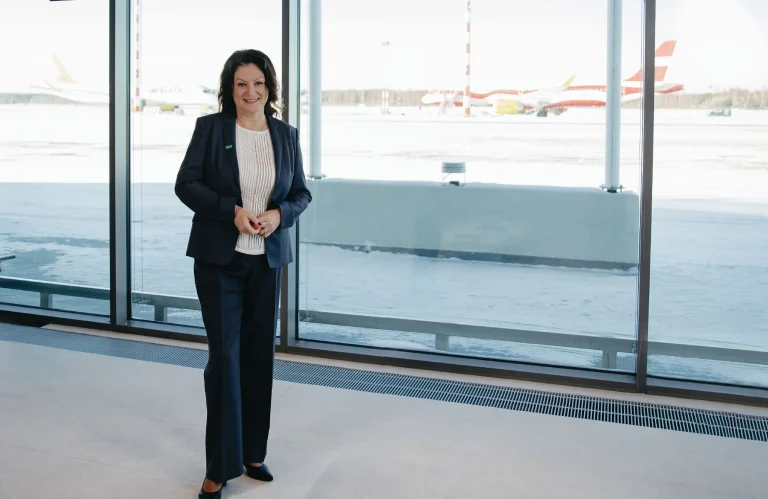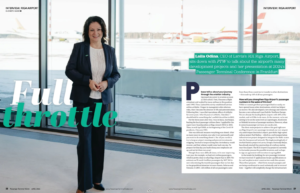Laila Odina, CEO of Latvia’s RIX Riga Airport, sits down with PTW to talk about the airport’s many development projects and her presentation at 2024’s Passenger Terminal Conference in Frankfurt
Please tell us about your journey through the aviation industry.
I pursued my career in aviation as soon as I left school. First, I became a flight attendant and worked for many airlines in this position until 1995. Then, I joined the newly established Latvian airline airBaltic. I began in managerial cabin relations roles, then I became the director of HR and administration. Following that, I was chief operations officer of airBaltic for seven years. After 16 years at airBaltic, I decided, ‘I should look for something else’, and left the airline in 2012. 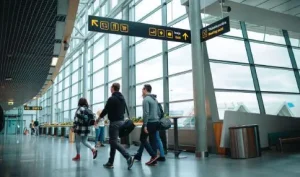
For the three years after this, I was in Baku, Azerbaijan, leading the local passenger airlines there. I applied for the supervisory board position at Riga Airport (RIX) in 2018. Then, in mid-April 2020, at the beginning of the Covid-19 pandemic, I became CEO.
This was difficult because everything was closed. After so many years in aviation, you take it very personally and you want to do something about it. But all you can do is try to keep an airport running and prevent investments stopping. You had to keep trusting that the industry would recover, and that volume would come back one day. To prepare for that day you had to keep your employees set up and not let them run away!
Though these were difficult times, we’re now improving. Last year, for example, we had 6.63 million passengers, which is pretty close to what Riga Airport had in 2019. We estimate we’ll reach 9 million passengers by 2027. We’re now only missing the transfer passengers that we lost due to the geopolitical situation between Russia, Belarus and Ukraine. In 2019, 1.26 million of all our passengers came from these three countries to transfer to other destinations – this made up 16% of all our passengers.
How will you strengthen Riga Airport’s passenger numbers in the wake of this loss?
While we cannot get these passengers back so easily, we have opened many other destinations, which has helped us recover. We also developed a new strategy and vision to become a new urban and travel hub for Northern Europe. We are already the leading Baltic airport, with 42% of the market, and we’d like to do more. At the moment, we’re not aiming to be on the same level as Copenhagen, Stockholm or Helsinki in terms of passenger numbers. However, when it comes to passenger services, we can do a lot.
The three main projects to achieve this goal right now are Riga Airport’s new passenger terminal, our new airport city and Eiropas Dzelzcela Linijas’s pan-Baltic high-speed railway project Rail Baltica – which is a rail transportation infrastructure project designed to integrate the Baltic states into the European rail network. The implementing body of the Rail Baltica project in Latvia, Eiropas Dzelzceļa līnijas, has already started the construction of a railway station near the airport. The RIX Airport City project is currently in the tender process for possible investors, and we hope to sign an agreement with investors in spring 2024.
In the tender for building the new passenger terminal we have received 17 applications for pre-qualifications so far, and we plan to start construction work this autumn. These three projects – which form mutual synergies and are being coordinated to excel technically and in terms of time – together will completely change the infrastructure of Riga Airport, attract more passengers and transform the airport into a destination in its own right.
Please tell me more about Riga Airport’s new terminal. 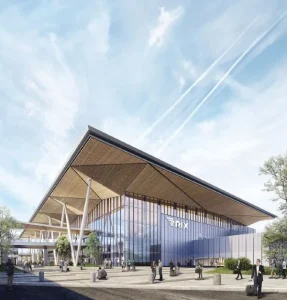
Riga Airport’s new passenger terminal project – designed by Italian design company One Works – combines advanced technology, passenger-focused amenities and a commitment to sustainability. Additionally, because One Works is designing both the terminal and the Rail Baltica station, there will be a certain harmony of design throughout the passenger experience.
The departure hall, bathed in ample natural light, offers a spacious environment for departing passengers. It features contemporary check-in islands and tailored amenities for individuals with special needs, such as tactile paths and an intuitive wayfinding system designed for clarity and ease of navigation. An accessible terrace atop the BHS provides a green, dual-function relaxation space. Its roof has local flora and night-time lighting, and is designed for future expansion. Ground-level exteriors with triangular, pyramid-shaped benches and landscaping offer an interactive environment.
The new security area fully integrates smart security concepts to streamline the process, making it quicker and less intrusive without compromising on safety. The new security area features 12 advanced lanes and automated pre-screening to speed up check-in and enhance security. These concepts are to streamline passenger flow, improve efficiency and cut costs while reducing wait times. Visible security officers provide oversight. Once through security, travelers access gates via escalators and elevators, simplifying their journeys.
The new BHS is designed for efficiency and future growth, anticipating passenger traffic to reach 12 million by 2036. Collaboratively planned with the building development team, it maximizes space and functionality for potential upgrades. The first floor features a make-up area with 30 chutes and belts for transferring luggage, plus elevators for oversized baggage and animals. The second floor focuses on security screening and has centralized control rooms for streamlined operations. This BHS upgrade is central to the airport’s evolution, ensuring a smooth service for passengers and airlines.
We’re working together with EBRD [European Bank for Reconstruction and Development] to finance the project and we want to finalize the design and construction details of the new passenger terminal, the Rail Baltica station and the first stage of RIX Airport City by 2028 – which is the same time the Rail Baltica train station is planned to be completed. This first stage of the airport city will consist of a hotel, office buildings and a Rail Baltica train station.
What role will Riga Airport’s recent rebrand play?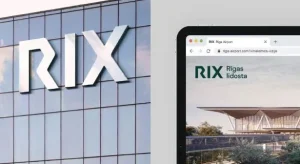
We’ve launched a rebrand of Riga Airport’s brand and visual identity to support these development plans. Right now, we have so many new projects that we’re expecting to see new businesses arising around our terminal and airport. That’s why this is exactly the right time to do this rebranding. We want to control what’s going on around the airport by controlling our identity, our values and our brand.
The rebranding has been quite a complicated process and took 10 months in total. However, we found it necessary because our terminal was built 50 years ago and the brand had not changed in all those years. It had the same colors and the same style.
The new brand name of Riga Airport is RIX Riga Airport, or RIX Rīgas Lidosta in Latvian. The name retains the internationally recognized airport code RIX, while the full name has been simplified. Riga Airport is located in a very green area with a forest on one side and the sea on the other side, so our new brand is based on this feeling and the experience of landing at Riga Airport – you see green and brown fields, the blue sea and the dark green forest.
The introduction of the brand has started and will be rolled out over the next four years. This year, the airport plans to introduce the new visual identity in more than half of the materials – in the digital environment, record-keeping materials, souvenirs, signs, terminal information materials, clothing, transportation and elsewhere.
“We are carrying out more than 200 different tasks in our sustainability strategy”
How is Riga Airport incorporating sustainability into these plans for the future?
We have so many projects that it’s difficult to know where to start! First of all, this new terminal project is completely redesigning everything we have right now around the land site area – it’s demolishing the existing air viaduct and building a new one. The design aims for BREEAM certification. This means that for the new terminal and the Rail Baltica station we will be looking for sustainable solutions and materials. For example, we plan to use wood for its sustainable qualities as well as its ability to reflect our local culture.
Alongside this, we are carrying out more than 200 different tasks in our sustainability strategy. We’re in the process of changing our entire fleet of aerodrome transportation vehicles to electric ones and building charging stations to support these vehicles, These, in turn, need about 40 electrical substations, which we’re also now building. We’re also getting nine electric passenger buses, new jet bridges and new passenger generators to replace the five old generators. Additionally, our first solar panels are installed on the roof of the existing terminal and plans to extend the existing solar panel plant are already in place. All these projects should be completed by the end of summer 2024, so by then we will be providing a completely different service to our passengers.
However, sustainability is inevitably a long-term project. Therefore, we are looking at a realistic timeline, and plan to reach net zero by 2035. This is because a lot of issues are still not clear and new environmentally friendly technologies are still currently under development, especially when it comes to, for example, heavy machinery needed to clear snow from the runway. In the meantime, we’ll be participating in R&D projects exploring the use of hydrogen in our operations.
What advice would you give to a new airport CEO?
My top tip for someone stepping into the role of airport CEO is to know a lot about infrastructure.
My background in airlines equipped me well for my interactions with civil aviation authorities and their regulations, customer expectations and what airlines anticipate from airports. However, I have zero background in engineering and infrastructure building processes and so on. Fortunately, I learn fast and I’m now spending most of my time overseeing these infrastructure projects.
Also, due to the industry’s set net zero targets, you’ll have to revise all your infrastructure to invent the solution that will achieve these sustainability goals. For example, the use of hydrogen at airports is a central topic at the moment. These questions are the future.
Another important thing for a CEO to focus on is the team and employees. I have a wonderful team around me, people who are real professionals working hard to deliver all these projects simultaneously. It’s a very challenging task and really only the best and most qualified people can do it.
What are your plans for Passenger Terminal Conference 2024?
It’s a three-day conference with so many interesting topics. I’m excited to hear about the latest developments in commercial areas and also the latest trends in customer service. This is because it will be very important for us to understand what solutions to pick for our new terminal. From the event, we can take the best tools for security, check-in, biometrics and all the latest technology.
My presentation will be about the design and development of Riga Airport’s new terminal and its facilities. In my talk, I think attendees will find a lot of topics that are at the front of their minds – such as sustainability, transitioning transportation fleets and installing solar panels – because many airports are in the same situation right now.
What’s different about our project is that we’re doing all this at once, with three major airport development projects. This is unique because usually you’d first develop the airport, then the train station and then the airport city over the span of approximately 20 years. However, we are building everything at the same time. So this is our biggest challenge but also a unique opportunity to build it in a modern, customer-friendly way.
I’m also looking forward to talking to other participants about the challenges of keeping existing airport infrastructure open while doing new construction work – especially those who have gone through it. Last year I had the pleasure of speaking to someone from Milan Bergamo Airport. The airport’s management team gave us lots of helpful insight into rebuilding a terminal while continuing to increase the number of passengers.
See Laila Odiņa’s presentation, ‘The new terminal at RIX Riga Airport’, on Day 1 of Passenger Terminal Conference 2024!
This article originally appeared in the April 2024 issue of Passenger Terminal World. To view the magazine in full, click here.


